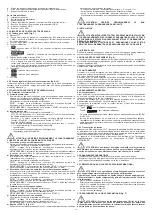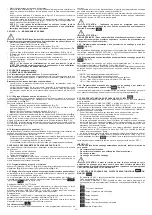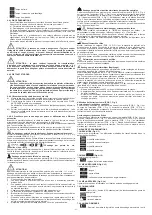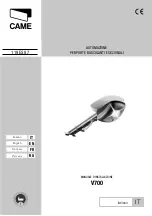
- 6 -
RESIDUAL RISKS
RISK OF UPPER LIMBS BEING CRUSHED
DO NOT PLACE HANDS NEAR MOVING PARTS!
Both the operating method for the spot welder and the variability in shape
and size of the piece being welded make it impossible to provide integrated
protection against the danger of the upper limbs being crushed: fingers, hands,
forearm.
The risk should be reduced by appropriate preventive measures:
- The operator should either be expert or trained in resistance welding
procedures using this type of appliance.
- A risk evaluation must be performed for each type of work to be carried out;
it is necessary to use equipment and masks that support and guide the piece
to be worked in order to distance hands from the electrode danger area.
- When using a portable spot welder: solidly grasp the clamp with both hands
placed on the relative handles; always keep hands away from the electrodes.
- Whenever the shape of the piece allows it, adjust the electrode distance so
that the stroke does not exceed 6 mm.
- Do not allow more than one person to work on the same spot welder at the
same time.
- Unauthorised persons should not be allowed in the working area.
- Do not leave the spot welder unattended: in such a case it should be
disconnected from the power supply; for pneumatic cylinder-operated spot
welders turn the main switch to “O” and lock it with the supplied padlock,
take out the key and leave it with the person in charge.
- Only use electrodes that are recommended for the machine (see spare parts
list) without altering their shape.
- RISK OF BURNS
Some parts of the spot welder (electrodes arms and nearby areas) may reach
temperatures of over 65°C: suitable protective clothing must be worn.
Allow newly-welded pieces to cool before touching them.
- RISK OF TIPPING AND FALLING
- Place the spot welder on a level horizontal surface that is able to support
its weight; confine the spot welder to the support surface (when required
in the “INSTALLATION” section of this manual). Otherwise with inclined
or uneven floors or moveable supporting surfaces there is the danger of
tipping.
- Never lift the spot welder unless explicitly required by the “INSTALLATION”
section of this handbook.
- When using machines on wheels: disconnect the spot welder from the
electric and pneumatic (if present) power supplies before moving the unit
to another work area. Pay attention to obstacles and unevenness on the
ground (for example cables and piping).
- UNINTENDED USE
It is dangerous to use the spot welder for any purpose other than that for
which it is intended (see INTENDED USE).
PROTECTIONS
The safeguards and moveable parts of the spot welder casing should all be in
position before connection to the power supply.
WARNING: All manual operations on moveable accessible parts of the spot
welder, for example:
- Electrode replacement or maintenance
- Adjusting the position of the arms or electrodes
MUST BE CARRIED OUT WITH THE SPOT WELDER SWITCHED OFF AND
DISCONNECTED FROM THE ELECTRIC AND PNEUMATIC (if present) POWER
SUPPLY.
MAIN SWITCH LOCKED AT “O” WITH LOCK CLOSED AND KEY REMOVED in the
models with PNEUMATIC CYLINDER movement).
STORAGE
- Place the machine and its accessories (with or without packaging) in closed
areas.
- The relative humidity of the air must not exceed 80%.
- The environmental temperature must be between -15°C and 45°C.
If the machine is planned with liquid cooling and an ambient temperature under
0°C: use the anti-freeze liquid suggested by the manufacturer or completely
empty the hydraulic circuit and the tank of liquid.
Always use adequate measures to protect the machine from humidity, dirt and
corrosion.
2. INTRODUCTION AND GENERAL DESCRIPTION
2.1 Introduction
Mobile system for resistance welding (spot welder) controlled by a microprocessor,
medium frequency inverter technology, three-phase power supply and direct output
current.
The spot welder is equipped with a pneumatic clamp that contains the transforming
and rectifying unit. In this way higher welding currents are obtained than from
traditional spot welders, with reduced network absorption and fewer magnetic fields
near the cables. Longer, lighter cables can be used to improve handling and give a
wider working range.
The spot welder can work on iron plates with a low carbon content, galvanized iron
plates, high resistance steel plates and boron steel plates. Equipped with quick
couplings for use with the accessory equipment (Studder, X Clamp), it can be used
for many different types of hot machining on panels and all the specific work of car
body shops.
The main system characteristics are:
- Backlit TFT display that shows the controls and the set parameters;
- Manual choice (MANUAL), semi-automatic (EASY) or completely automatic
(SMART) of the spot welding parameters;
- Possibility of setting pre-heating and post-heating of the sheet metal to optimise
welding of the high resistant and galvanised materials;
- Possibility of setting different types of electrodes and arms;
- Automatic recognition of the clamp or studder connected;
- Automatic control of the spot welding current;
- Manual and automatic control of the electrode forces;
- USB port.
2.2 STANDARD ACCESSORIES
- Arm support;
- Clamp cable support;
- Regulator filter group (supply of compressed air);
- “C” clamp with standard arms, complete with cable with a plug that can be
disconnected from the generator and built-in sensors for automatic spot;
- Cooling system (integrated GRA).
2.3 ACCESSORIES ON DEMAND
- Arms and electrodes with a different length and/or shape for “C” clamp (see spare
parts list);
- Electrodes kit (see spare parts list);
- Supporting pole and weight discharger for the clamp;
- “X”, “C” clamp (see spare parts list);
- Studder kit;
- “C” clamp ring kit.
3. TECHNICAL INFORMATION
3.1 RATING PLATE (Fig. A)
The main information about use and performance of the spot welder is summarised on
the rating plate and has the following meanings:
1 - Number of phases and frequency of the power line
2 - Power supply voltage
3 - Network output at permanent capacity (100%).
4 - Nominal network output with duty cycle of 50%.
5 - Maximum no-load voltage to electrodes.
6 - Maximum current with electrodes in short-circuit.
7 - Secondary output at permanent capacity (100%).
8 - Arm gauge and length (standard).
9 - Minimum and maximum adjustable force to electrodes.
10 - Nominal pressure of the compressed air source.
11 - Compressed air pressure required to obtain maximum force to the electrodes.
12 - Cooling liquid capacity.
13 - Drop in nominal pressure of the cooling liquid.
14 - Spot welder device earthing
15 - Safety symbols whose meanings are illustrated in Chapter 1 “General safety for
resistance welding”.
N.B.:
The rating plate shown is an example to explain the meanings of the symbols
and figures; the exact technical specifications for your machine should be taken
directly from the rating plate on the machine itself.
3.2 OTHER TECHNICAL DATA
3.2.1 Spot welder
General features
- Power supply voltage and frequency
:
400V (±15%) ~ 3-ph-50/60 Hz
- Electric protection rating
:
I
- Insulation rating
:
H
- Casing protection rating
:
IP 20
- Cooling type
:
liquid
- (*) Overall size (LxWxH)
:
820 x 610 x 1150 mm
- (**) Weight
:
80 kg
Input
- Max. power in short-circuit (Scc)
:
88 kVA
- Delayed network fuses
:
32 A
- Automatic circuit breaker
:
32A (“C”- IEC60947-2)
- Power supply cable (L≤8m)
:
4 x 6 mm²
Output
- Loadless secondary voltage (U
2
d)
:
13V
- Max. spot welding current (I
2
max)
:
13kA
- Spot welding capacity
:
max 3 + 3 + 3 mm
- Intermittence ratio
:
2%
- Maximum power at electrodes
:
580 daN
- Length of “C” arm
:
95 mm standard
- Spot welding current adjustment
:
automatic and programmable
- Spot welding current time adjustment
:
automatic and programmable
- Squeeze time adjustment
:
automatic and programmable
- Slope time adjustment
:
automatic and programmable
- Maintenance time adjustment
:
automatic and programmable
- Cold time adjustment
:
automatic and programmable
- Adjustment of number of impulses
:
automatic and programmable
- Pre-heating time/current adjustment
:
automatic and programmable
- Post-heating time/current adjustment
:
automatic and programmable
- Post-heating time adjustment
:
automatic and programmable
(*) NOTE: the overall dimensions do not include the cables and the supporting pole.
(**) NOTE: the generator weight does not include the clamp and the supporting pole.
3.2.2 Cooling system (GRA).
General features
- Maximum pressure (pmax)
:
3 bar
- Cooling capacity (P @ 1l/min)
:
2 kW
- Tank capacity
:
8 l
- Cooling liquid
:
coolant
4. DESCRIPTION OF THE SPOT WELDER
4.1 SPOT WELDER UNIT AND MAIN COMPONENTS (Fig. B)
On the front:
On front:
1 - Control panel;
2 - USB port;
3 - Outlet for clamp connection;
4 - Rapid hold to attach the cooling tubes;
5 - Outlet for connecting the sensors used with the automatic spot;
6 - Clamp cable support.
On the back:
7 - Main switch;
8 - Supply cable input;
9 - Arm supports;
10 - Pressure regulator, pressure gauge and air intake filter;
11 - Cooling system tank cap (GRA);
12 - GRA liquid level;
13 - GRA air exhauster.
4.2 CONTROL AND ADJUSTMENT DEVICES
4.2.1 Control panel (Fig. C)
1- TFT Display.
2- Cooling unit locking button. It allows you to lock the “GRA” during the welding
process to facilitate replacement of the arm and/or electrodes.
3- “Quick Menu” button. Rapid access to the useful menus during welding.
4- Multi-function button:
-
: access to the “SERVICE” menu in alarm conditions or before pressing
START;
Summary of Contents for 823350
Page 154: ... 154 FIG A FIG B 1 2 3 5 4 6 7 8 9 10 11 12 13 ...
Page 156: ... 156 FIG E FIG F 3 2 1 ...
Page 157: ... 157 FIG G5 A B FIG G1 FIG G2 FIG G4 FIG G3 A B ...
Page 158: ... 158 FIG L FIG I ...
Page 159: ... 159 FIG M FIG N FIG O FIG P ...
Page 160: ... 160 FIG Q FIG R FIG S FIG T 1 2 1 ...
Page 161: ... 161 1 2 3 4 5 6 7 8 9 10 11 12 13 14 15 16 17 18 FIG U ...







































